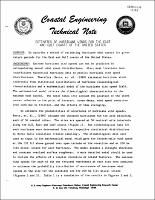Please use this identifier to cite or link to this item:
https://hdl.handle.net/11681/2340Full metadata record
| DC Field | Value | Language |
|---|---|---|
| dc.contributor.author | Coastal Engineering Research Center (U.S.) | - |
| dc.date.accessioned | 2016-03-11T20:51:20Z | - |
| dc.date.available | 2016-03-11T20:51:20Z | - |
| dc.date.issued | 1985-12 | - |
| dc.identifier.uri | http://hdl.handle.net/11681/2340 | - |
| dc.description | Technical note | - |
| dc.description | BACKGROUND: Extreme hurricane wind speeds cannot be predicted by extrapolating annual wind speed distributions. Also, most locations have insufficient historical hurricane data to predict hurricane wind speed distributions. Therefore, Batts, et. al. (1980) estimated hurricane winds indirectly from statistical distributions of hurricane climatological characteristics and a mathematical model of the hurricane wind speed field. The mathematical model relates the climatological characteristics to the maximum wind speeds. The model takes into account the position of the storm center relative to the point of interest, storm decay, wind speed reduction over land due to friction, and the effects of time averaging. | - |
| dc.publisher | Coastal Engineering Research Center (U.S.) | - |
| dc.publisher | Engineer Research and Development Center (U.S.) | - |
| dc.relation | http://acwc.sdp.sirsi.net/client/en_US/search/asset/1000130 | - |
| dc.relation.ispartofseries | Coastal engineering technical note ; CETN-I-36. | - |
| dc.rights | Approved for public release; distribution is unlimited. | - |
| dc.source | This Digital Resource was created from scans of the Print Resource. | - |
| dc.subject | Hurricane | - |
| dc.subject | Monte Carlo simulation | - |
| dc.subject | Shorelines | - |
| dc.subject | Storm center | - |
| dc.subject | Storm decay | - |
| dc.subject | Wind speed distributions | - |
| dc.title | Estimates of hurricane winds for the East and Gulf Coasts of the United States | - |
| dc.type | Report | en_US |
| Appears in Collections: | Technical Note | |
Files in This Item:
| File | Description | Size | Format | |
|---|---|---|---|---|
| CETN-I-36.pdf | 389.82 kB | Adobe PDF |  View/Open |